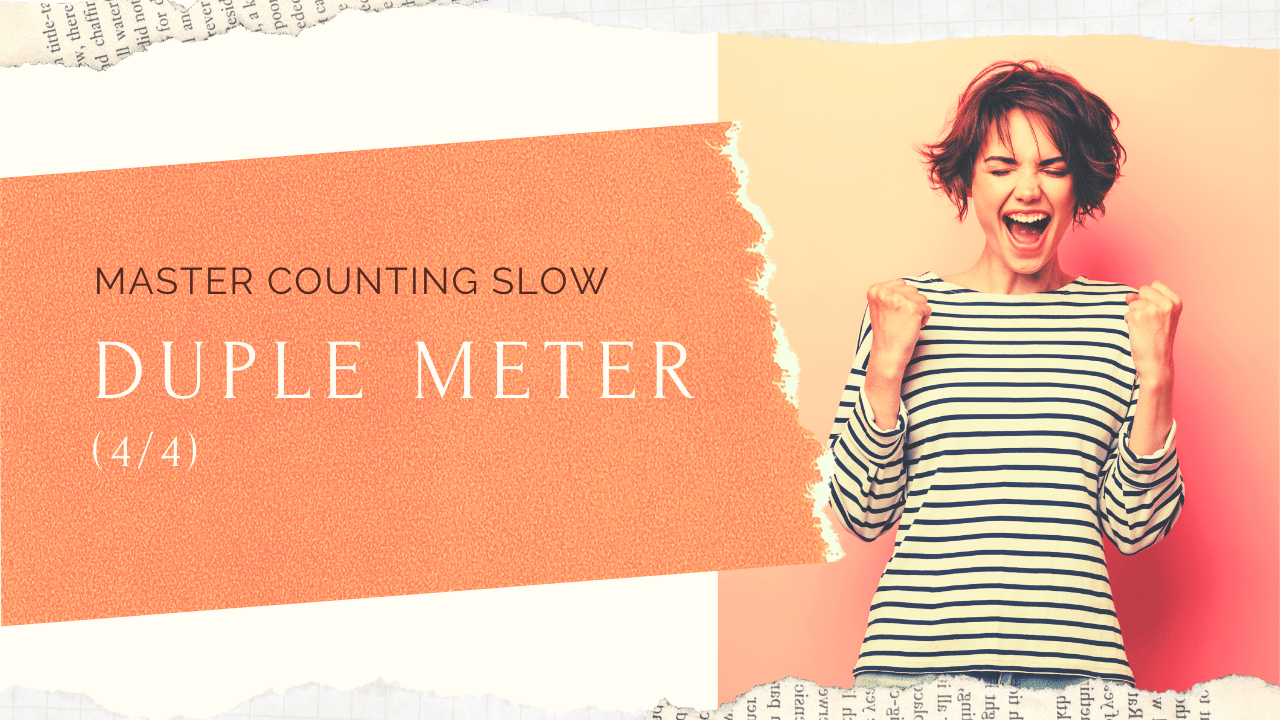
Blog #35 Master Counting Slow Duple Meter (4/4s)
Dec 29, 2020Slow Duple Meter for Plies?! Why? How?
20 years ago, when I began to play for ballet as a young innocent, still wet behind the ears from getting my degree in performing arts, I found the art of accompanying ballet and understanding how music was relevant to the movement, absolutely mind numbing.

There were tons and tons of movements and piles and piles of music! Slowly certain movements and music began to click and make sense. Certain parts of a ballet class became a comfort zone for me..a happy place in an hour and a half of mostly misery. lol.

There were 2 types of music/movement combinations that particularly threw me for a loop every time. The duple meter (4/4 generally) plies and tarantellas! Worlds apart in sound and quality but for some reason those two music types were a real challenge for me.
Today I want to dive into the slow 4/4 or duple meter.
Exploring the Adagio Duple Meter
Triple Meter is a Comfort Zone for a Reason
Many teachers primarily use triple meter for plies so that quickly became a comfort zone for me. It made sense.
I could see and feel the moment for breath in the music. One of the 3 beats was the opportunity for the allongé and the rest of each dancer count was for the start of the movement and the middle of the movement. It was clear to me. For example, a grand plie began like this..

The allongé is on the 'a' of a previous dancer count and then demi-plie happens on the dancer count (or beat 1) and continues down into the grand plie on the next dancer count. The 3rd beat of a measure becomes this fabulous moment for the allongé. Triple meter made sense to me, for plies.
For slow tendus triple meter again made a lot of sense to me.
When it came to a slow tendu, it made perfect logical sense to put it on a triple meter; more time (3 beats instead of 2) for the movement, which is generally the point with slow tendus. More time to go through the movement and feel all the parts of the foot pressing on the floor. Time is the key factor here.
Somehow when I removed one of those 3 beats by playing a duple meter, it felt like there was no time for the allongé in a grand plie. It felt weird to me for the movement to be complete in such a short time!
Slow tendus were the same, how is the dancer pressing into the floor and feeling the different parts of the foot pressing against it with such a short amount of time between counts?
Likely part of the weirdness was the fact that some of the teachers themselves were uncomfortable counting a slow duple meter rhythm for plies or tendus.
It feels as if you're rushed because the dancer count is the beginning of the movement and all you've got is an '&' before you're already back at a dancer count! It feels too fast often! Am I right?!
Breaking it down and making it work!
So here is the deal to making this work for you.. You have to understand that the 4/4 (or duple meter) is going to feel SLOW and that's ok. Take a look at this picture below. You'll notice that I've organized 2 dancer counts of triple meter AND 2 dancer counts of duple meter in the same amount of space (or time). Let's say you count the triple meter '1 & a 2 & a '. When you count the duple meter underneath, '1 & 2 &', it should take the same amount of time (or a hair slower or faster, lol)!

This is KEY to internalizing (and then counting) the tempo and feel of a duple meter plie or slow tendu.
What you have to realize, is that if you count the duple meter '1 &' at the same speed as your triple meter, it's going to be fast for your dancers. Do you follow?

Now what happens is, either, you, your pianist and your dancers think your exercise is really fast and end up changing it back to a 3..
OR
You, as a teacher, feel the tempo and know it's too fast so you insert a pause of silence between the dancer counts..behold..it's slower now!

You have now departed from duple meter and are back to counting a 3! No matter where you put that magical silence so that your 'duple meter' exercise doesn't feel so fast, it's still a 3!
Sometimes I hear 1___ & 2___ & 3___.. there's something about counting super slow that makes it oh so easy to extend some words longer than others (aiming to demonstrate the movement quality) and by doing so, turning your duple meter back into a triple!
The answer is how you hand the space between the counts. If you can really nail down the & being EXACTLY the same amount of time as your count, you're golden!
I hope this dramatically cleared up the duple meter (often a 4/4) plie and tendu challenge!
If you're hoping to get better at this as well as many other music types and LOVE to develop your music theory knowledge and skills, make sure you register to join my music training course called: The Official Music Training Course for Ballet Teachers | Part 1 or at the very least, get on the wait list to get first notice the next time registration opens up!
Stay connected with news and updates!
Join our mailing list to receive the latest news and updates from our team.
Don't worry, your information will not be shared.
We hate SPAM. We will never sell your information, for any reason.


